A Total-Body Workout in 5 Easy Steps
Part 3: The Legs
By Chelsea Cooper
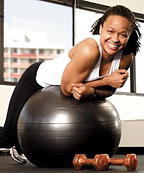 All photographs taken at Club No Mercy Intensity Performance Training Studio (www.clubnomercy.com) in Huntington Beach, Calif.
All photographs taken at Club No Mercy Intensity Performance Training Studio (www.clubnomercy.com) in Huntington Beach, Calif.
Chelsea Cooper, certified personal trainer and fitness expert, continues her five-part series covering each of the major muscle zones. This month, learn the best exercises to build lower-body strength and tone your legs. When putting together a weight-lifting routine, don't forget the legs. In particular, many men want big chests and biceps and forget about the legs. This is not advisable - you'll end up looking disproportionate and you'll be more susceptible to injuries. Additionally, it is counterproductive. The body likes to grow all at once, so making sure you work on upper and lower body evenly helps your overall appearance. There is an undeniable synergy within the body. Treat your body as a whole, appropriately paying attention to all the major muscle groups, and it will respond. Leg training is more important than training any other body part when it comes to achieving your overall goals. Legs are an integral part of your workout, so let's begin!
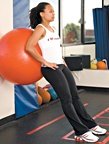 Keep feet shoulder-width apart, toes pointed forward.
STABILITY BALL SQUATS
Keep feet shoulder-width apart, toes pointed forward.
STABILITY BALL SQUATS Getting Started 1 Stand with your feet shoulder-width apart, toes pointing forward and your knees slightly flexed over your second and third toes. Press your lower back against a stability ball that is placed on a wall. 2 Ideally, you should keep your feet directly under your knees. (For individuals who have tight calves or knee problems, place your feet slightly in front of your knees.)
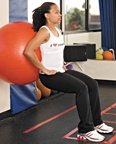 Keep chest up and apply pressure in heels.
Movement
Keep chest up and apply pressure in heels.
Movement 3 Draw in your abs and activate your glutes. 4 Begin to squat down, bending your knees and flexing your hips, and keeping your feet straight (as if sitting in a chair). Do not allow your hips or knees to rotate. 5 Allow your pelvis to slightly sit back under the ball while maintaining good posture. 6 Keep your chest up and apply pressure through the heels. Do not rely solely on the ball for support. 7 To stand back up, squeeze your glutes and apply pressure through the heels as your knees are extended. 8 Stand up straight until your hips and legs are fully extended. Avoid using your lower back when standing back up. LEG PRESS Getting Started 1 Lie back on the leg press machine. Make sure your back is flat against the pad.
 Make sure back is flat against pad.
2 Make any adjustments necessary to fit your body.
Make sure back is flat against pad.
2 Make any adjustments necessary to fit your body. 3 Place your feet shoulder-width apart, with your toes pointing forward and your knees directly over your second and third toes. Movement 4 Draw in your abs and activate your glutes.
 Draw in abs and activate glutes.
5 Push the platform away from your body in a smooth motion by flexing at the knees and hips. Apply pressure through your heels to full extension. Never lock your knees.
Draw in abs and activate glutes.
5 Push the platform away from your body in a smooth motion by flexing at the knees and hips. Apply pressure through your heels to full extension. Never lock your knees. 6 Pause momentarily. 7 Repeat.
 Position feet shoulder-width apart.
LUNGES
Position feet shoulder-width apart.
LUNGES Getting Started 1 Begin with your feet shoulder-width apart and your toes pointed straight ahead. 2 Hold a dumbbell in each hand. Movement 3 Draw in your abs and activate your glutes. 4 Lunge forward, landing on the heel of the lunged foot.
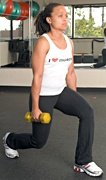 Both knees should end at a 90 degree angle.
5 Come to a stabilized position with your front foot pointing straight ahead and your knee directly over your second and third toes.
Both knees should end at a 90 degree angle.
5 Come to a stabilized position with your front foot pointing straight ahead and your knee directly over your second and third toes. 6 Both knees should now be bent at a 90 degree angle. Your front foot should be flat on the ground and the heel of your back foot should be lifted off the ground. 7 From this position, push off of your front foot (heel first) onto your back leg. 8 Repeat on the other leg. WORKOUT BASICS Repetitions And Sets: Same for both men and women; varies depending on individual goals (toning muscle vs. building muscle vs. building strength). Intensity: This is the percentage of your one-rep maximum (the maximum amount of weight you can lift at one time). For example, if your goal is to build muscle, you would perform repetitions using 70 percent to 75 percent of your one-rep maximum (see below). That means that if you can bench press 100 pounds one time, you would perform each repetition using a maximum of 75 pounds of weight. Toning Muscle (Strength/Endurance) Sets: 2-3 /// Reps: 15-25 /// Intensity: 50% - 70% Building Muscle (Hypertrophy) Sets: 3 /// Reps: 9-12 /// Intensity: 70% - 75% Strength Adaptation Sets: 3-4 /// Reps: 6-8 /// Intensity: 75% - 85% CALVES
 Keep hands down at side, palms in.
Keep hands down at side, palms in.
STANDING CALF RAISE Getting Started 1 Stand up straight with your feet hip-width apart and your toes pointed straight ahead. 2 Squeeze your glutes.
 Keep knees straight, but not locked.
3 Hold a dumbbell in each hand hanging down at your sides, palms in.
Keep knees straight, but not locked.
3 Hold a dumbbell in each hand hanging down at your sides, palms in. Movement 4 Keep your knees straight and stiff, but not locked. 5 Raise up onto the balls of your feet, as high as possible, and hold for a second while flexing the calf muscles. 6 Return to the starting position in a slow, controlled manner.

Standing calf raises also can be performed one leg at a time.
HAMSTRINGS STABILITY BALL LEG CURL Getting Started
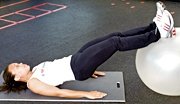 Keep legs fairly straight.
1 Lie on the floor with your heels on the stability ball and your arms at your hips.
Keep legs fairly straight.
1 Lie on the floor with your heels on the stability ball and your arms at your hips. 2 Keep your legs fairly straight, and on an exhale, lift your hips up as high as you can (this works the lower back, glutes and hamstrings). 3 Keep your abs tight and activate your glutes (this will keep your legs from rolling off the ball). Movement
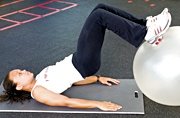 Prevent hips from touching the floor.
4 Keep your hips in the air and then bend at the knees, bringing your feet up on top of the ball, and roll the ball in toward your glutes.
Prevent hips from touching the floor.
4 Keep your hips in the air and then bend at the knees, bringing your feet up on top of the ball, and roll the ball in toward your glutes. 5 Reverse the sequence. Do not let your hips hit the floor; keep them in the air. 6 Repeat. HAMSTRING CURL
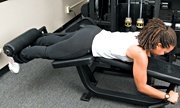 Keep hips flush against bench.
Getting Started
Keep hips flush against bench.
Getting Started 1 Lie flat on your stomach. 2 Keep your hips flush against the bench. 3 Keep your abdominal muscles tight, with a natural arch in your spine. Movement
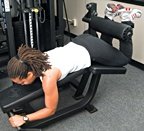 Curl weight at a 90 degree angle.
4 In a controlled motion, curl the weight up to a 90 degree angle from the machine.
Curl weight at a 90 degree angle.
4 In a controlled motion, curl the weight up to a 90 degree angle from the machine. 5 Stop where you feel comfortable (do not let your hips come up) and squeeze your glutes. 6 In a controlled motion, lower the weight, stopping just before your knees are straight, and reverse the motion back up. Good luck, and enjoy your workout! Next month, we'll focus on firming and toning the back and shoulders.
Chelsea Cooper, MPA, CPT, is certified by the National Academy of Sports Medicine as a personal trainer, performance enhancement specialist, and rehab and exercise specialist. To learn more, visit www.trainwithchelsea.com.
Page printed from:
http://www.toyourhealth.com/mpacms/tyh/article.php?id=946&pagenumber=3&no_paginate=true&no_b=true
| 

